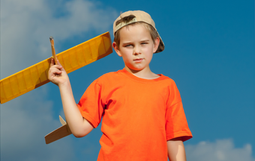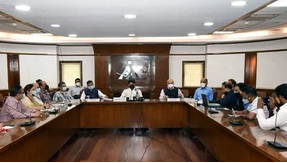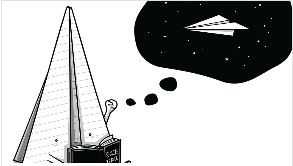Swarm intelligence is the collective behavior of autonomous, decentralized systems like fish schools, ant colonies, or flocks of birds. Swarm intelligence may be used in robotics to create and manage a group of robots that work together to complete a task, including exploration, mapping, or surveillance. The use of swarm intelligence in environmental monitoring, Surveillance, Light Shows, etc. is discussed in this blog.
Here are some of the possible benefits of drone swarms:
1. Cooperative Flight of Drone Swarms
Cooperative flying allows drones in a swarm to communicate and coordinate their activities, resulting in more capability than individual drones. They may collaborate to complete difficult tasks, communicate information, distribute burdens, and adapt to changing circumstances. Swarm intelligence, decentralized decision-making, and communication protocols may all be used to attain this level of cooperation. Drone swarm cooperative flying is an exciting field of study that has the potential to revolutionize a wide number of businesses. Multiple drones collaborate in a coordinated manner to achieve a common goal in this strategy. This may be performed in a variety of ways, including the use of communication protocols, swarm algorithms, and artificial intelligence. A swarm of drones, for example, may survey a big region in less time than a single drone, or they can be used to search for missing people in a more comprehensive manner. The cooperative flight also provides for redundancy by assigning numerous drones to the same job, guaranteeing that it is performed even if one or more drones fail. It can also increase safety by allowing drones to share information and avoid collisions. Precision agriculture, search and rescue operations, disaster response, and military activities are all possible uses for cooperative flight of drone swarms.
2.Surveillance and Monitoring by drone swarm
Drone swarms are also increasingly being employed for surveillance and monitoring. Swarms of drones outfitted with cameras and other sensors can be used to swiftly and efficiently monitor enormous regions. This is especially beneficial in situations when human surveillance is impossible or hazardous, such as disaster or conflict zones. The ability of drone swarms to cover a bigger area than a single drone is one of its advantages in surveillance. The drones can give a more complete picture of the region being watched if they work together in a coordinated manner. Additionally, they may be programmed to follow certain pathways or patterns, which makes it simpler to spot environmental changes or abnormalities. Drone swarms are utilized for environmental monitoring in addition to surveillance. They can have sensors that detect the temperature, air quality, and other environmental variables. This data may be used to spot areas that need improvement and track how the environment evolves over time.
3.Search and Rescue Operations by drone swarms
The use of drone swarms may improve search and rescue efforts. They can rapidly traverse enormous search regions, find victims or survivors, and relay information to the rescue crews. Swarms can work together to map disaster-affected areas, evaluate damage, and choose paths that are safe for first responders. Drone swarms have the advantage of being able to search a bigger area than a single drone or human search team. The drones can offer a more thorough perspective of the region being searched by cooperating in a coordinated manner. Additionally, they may be trained to adhere to predetermined patterns or search algorithms, which makes it simpler to locate possible targets. Drone swarms are utilized for disaster response in addition to search and rescue. After a natural disaster, such as an earthquake or hurricane, they can be used to evaluate the damage and pinpoint the regions that need repair. They may also be used to bring food, medicine, and other necessities to disaster zones.
4.Environmental Monitoring by Drone Swarms
4.1 Why environmental monitoring?
The practice of gathering and analyzing data on the status and changes of natural phenomena, such as climate, biodiversity, pollution, or natural catastrophes, is known as environmental monitoring. Understanding and controlling the effects of human activity on the environment, as well as identifying and responding to environmental threats and crises, all depend on environmental monitoring. However, because it requires exploring a wide range of terrain, navigating unpredictable weather, and assuring the accuracy and dependability of the data, environmental monitoring is also a difficult endeavor.
4.2 How swarm intelligence can help?
Swarm intelligence may benefit environmental monitoring in a number of ways, including scalability, adaptability, and resilience. Scalability refers to the capacity of swarm robots to handle high-dimensional data and cover wide regions without relying on a central coordination or communication system. By utilizing local rules and feedback, swarm robots are flexible in that they can adjust to shifting tasks and environmental situations. Swarm robots are robust when they rely on redundancy and self-organization to withstand failures and disruptions. Swarm intelligence can also offer innovative skills including cooperative manipulation, distributed sensing, and collective learning.
4.3 What are the main challenges?
Despite the potential advantages, using swarm intelligence for environmental monitoring comes with a number of difficulties, including deployment, design, control, and assessment. Design is the process of determining the best trade-off between a swarm of robots' individual and collective characteristics, including their size, form, movement, sensing, and processing. The issue of defining and putting into place the local laws and interactions that lead to the intended overall behavior of the swarm robots, such as collaboration, cooperation, or competition, is referred to as control. Evaluation deals with the issue of calculating and confirming the swarm robots' effectiveness and performance in both simulation and actuality. Deployment refers to the challenge of moving and sustaining the swarm of robots in the actual world while addressing concerns like power, communication, or safety.
4.4 What are the main opportunities?
The use of swarm intelligence for environmental monitoring has a number of potential for innovation, integration, and effect, notwithstanding the difficulties. Swarm intelligence can lead to innovation by generating fresh ideas for environmental monitoring techniques based on the workings of actual swarms. Swarm intelligence may be integrated such that it can improve and supplement other environmental monitoring tools, such as satellites, drones, and sensors. Impact refers to the ability of swarm intelligence to advance environmental monitoring's social and environmental objectives, such as awareness, education, or conservation.
4.5 Examples























Great article! Your insights on drone swarms shed light on their immense potential in various industries. I particularly appreciated your discussion on how drone swarms can revolutionize disaster response efforts. The ability to quickly deploy multiple drones for search and rescue missions can significantly improve efficiency and save lives. it also raises some ethical concerns. Anyway, keep up the good work!